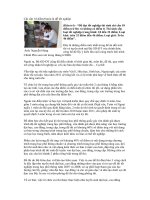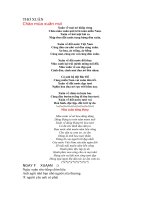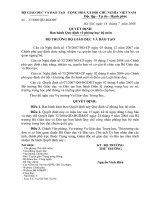CT moi cua BGD Tuan 9
Bạn đang xem bản rút gọn của tài liệu. Xem và tải ngay bản đầy đủ của tài liệu tại đây (112.86 KB, 5 trang )
<span class='text_page_counter'>(1)</span>WEEK 9 PERIOD 33 SHORT STORY: CAT AND MOUSE I. Objectives: - By the end of this lesson, students will be able to PRACTICE all the knowledge they have learn - Develop speaking skill. - Ss look after , solve problems and study themselves. - Studious and obedient students and love their friends. II. Teaching methods: - Communicative approach. - Techniques: Ask and answer (say individually);Work in pairs/ groups;Discuss. III. Teaching aids: - Teacher’s aids: student’s and teacher’s book, word cards, pictures, puppets. IV. Languages focus: Vocabulary: cat, mouse, story, cousin V. Procedures: 1.Presentation a. vocabulary: cat, mouse, story, cousin ( picture, real object).I’m very well. b. Set the scene: Have Ss look at the pictures and introduce six characters. Teacher describe the content of each picture. Ss look at the picture and read the story Ss look at the picture carefully and listen to the tape. 2. Practice a. Complete the conversation - Ss look & read silently the sentences. Then complete the sentences in individual. - Have Ss trade their answers in pairs for correction. - Ss to read the answers aloud to the class. The others listen and give comments. - Check and correct. - Ask some questions to ensure Ss’ comprehension of the listening text. b.Work in groups of three - 1st reading: Ss read the sentences individually . - 2nd reading: Ss do read the sentences in groups of three. - Ss act the conversation out with their names. - Call on some Ss to role play in front of the class.. Others listen and comment. c. Unscramble these words from conversation - Asking Ss to unscramble in individual. - Call some Ss to write on the board. The rest give comment. - Correct. Period 34: TEST 1 Period 35.
<span class='text_page_counter'>(2)</span> UNIT 6: WHERE’S YOUR SCHOOL? Lesson 1 (1-2) I. Objectives: By the end of the lesson, students will have been able to ask and answer questions about where a school is. II. Language focus: - Vocabulary: street, road, village, district, cousin. - Structures: Where’s your school? It’s in + (place) III. Resources: - Teacher’s: Pictures, recording - Students’: Book, notebook IV. Procedure: Activities Interactions 1. Warm up. - Spend a few minutes asking and answering questions about the pupil’s school. 2. Look, listen and repeat. -Tell pupils that they are going to learn to ask and answer questions about where their school is. - Have them look at the four pictures to discuss the content in which the language is used. Ask them questions such as Who are the pupils? Where are they? And What are they talking about? - Play the recording a few times for pupils to listen and repeat. Do choral and individual repetition, pointing to the characters speaking - Play the recording again for them to listen and repeat. 3. Point and say -Tell pupils that they are going to practice asking and answering questions about where a school is, using Where’s your school? It’s in + (place) - Have them look at the bubbles and the pictures to understand how the language is used in different contexts. Point to the first picture and teach the word Oxford Street. Get pupils to ask the question Where’s your school? and give the answer It’s in. - Whole class. - Whole class. - Whole class - Individual - Whole class - Whole class. - Whole class - Individual,.
<span class='text_page_counter'>(3)</span> Oxford Street chorally and individually. Then tell them to practice asking and answering the question in pairs, using the prompts in the bubbles and the words under the picture. - Repeat the same procedure with the rest of the pictures. - Call a few pairs to act out the dialogue in front of the class. Check as a class and correct pronunciation, if necessary. * Work in pairs. Ask and answer questions about your school. Ask its name and where it is. - Tell pupils that they are going to say the name and location of their own school. - First, tell pupils to work in pairs: one pupil asks What’s the name of your school? Where is it? and the other answers My school is + (school). It’s in + (place). 4. Reinforcement: - Recall the main content. 5. Homelink: - Prepare the next period.. Pair work. - Pair work. - Whole class - Pair work. - Whole class - Whole class. Period 36 UNIT 6: WHERE’S YOUR SCHOOL? Lesson 1 (3-4-5) I. Objectives: By the end of the lesson, students will have been able to listen for detail information and write about where the schools are..
<span class='text_page_counter'>(4)</span> II. Language focus: - Vocabulary and structures: Review III. Resources: - Teacher’s: Pictures, recording - Students’: Book, notebook IV. Procedure: Activities Interactions 1. Warm up. - Spend a few minutes revising the previous lesson. Call a few pupils to the front of the class to talk/write about their school. 2. Listen and tick. - Tell pupils that they are going to listen to three dialogues and tick the correct pictures. - Have pupils look at the pictures to identify the similarities and differences by saying what the schools are and where they are. Have them read aloud the names of the schools and their location. Check understanding. - Play the recording a few times. Ask pupils to listen to the recording and tick the correct pictures. Tell them to focus on the names of the schools and their locations. - Get pupils to swap their answers before you check as a class. Monitor the activity and offer help, if necessary Key: 1. c 2. a 3. c 3. Look and write. - Tell pupils that they are going write where the schools are. - Give a few seconds for pupils to look at the pictures. First, focus pupils on the locations of the schools. Then have them look at the sentence under each picture and find the appropriate words to complete the sentence. If necessary, get them to work in pairs. - Get pupils time to do the task independently. Go around and offer help, if necessary. - Get pupils to swap their answers before checking as a class. If there is enough time, call a few pupils to read aloud complete sentences.. - Whole class. - Whole class. - Individual. - Pair work. - Whole class. - Pair work - Individual - Pair work.
<span class='text_page_counter'>(5)</span> Key: 1. Nguyen Trai Street 2. in Van Noi Village 3. is in South Street, London 4. Let’s sing. - Tell pupils that they are going to sing the song This is the way. Teach the song following the procedure in the Teaching the unit components in the Introduction - Read the song and check comprehension. Give the meaning of unfamiliar vocabulary. Play the recording or sing the song all the way through. - Have choral and individual repetition of each line of the lyrics. When pupils are familiar with the tune, give a demonstration of the song and actions. - Get groups of pupils to sit face to face and practise singing and doing the actions. - Call a group of six to the front of the class. The group sings the first four lines in every stanza and the rest of the class sings the last four lines. - Have the whole class sing the song to reinforce the activity. 5. Reinforcement: - Recall the main content. 6. Homelink: - Prepare the next period.. - Whole class. - Whole class - Individual - Group work. - Whole class - Whole class - Whole class.
<span class='text_page_counter'>(6)</span>









